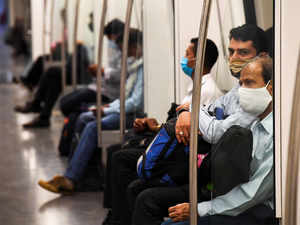 AFP
AFPNEW DELHI: Delhi Metro is going to mark another first for the country — a “Made in India” signalling system. Arguably the most critical component of the Metro train operations, Delhi Metro Rail Corporation (DMRC) and other such entities in the country now depends on foreign manufacturers for sophisticated signalling systems.
On Tuesday, DMRC took a major step towards the development of an indigenously built communication-based train control (CBTC)-based signalling technology for the Metro with the launch of i-ATS (indigenous automatic train supervision), an important sub-system of the signalling system. This prototype system and a laboratory for further developing other sub-systems of the indigenous CBTC technology were inaugurated at Shastri Park by Durga Shanker Mishra, secretary of the Union housing and urban affairs ministry.
TOI was the first to report in March last year that DMRC is going to develop its own signalling system in collaboration with Centre for Development of Advanced Computing, Bharat Electronics Ltd (BEL), Niti Aayog and the ministry to become self-reliant and also help other metro operators in the country. While most components for Metro systems and trains are now made in India, DMRC is heavily dependent on Germany-based Bombardier and Siemens, and France-based Alstom for the signalling system.
“ATS is a computer-based system, which manages train operations. It is indispensable for high-density operations such as the Metro, where services are scheduled every few minutes,” said Anuj Dayal, executive director of corporate communications at DMRC.
To take the project forward, DMRC and BEL entered into a MoU for development of the indigenous ATS system. A dedicated team of DMRC and BEL Ghaziabad worked together round the clock to take this important step towards “Atmanirbhar Bharat”, Dayal said. “DMRC has decided to use i-ATS while upgrading the ATS of Red Line, from Rithala to Shaheed Sthal, Ghaziabad and in phase IV,” he said.
i-ATS can work with different suppliers and different levels of technologies of train control and signalling systems, and is also suitable for introduction in Indian Railways, which is now introducing centralized train control at a large scale that uses parts of ATS functions, Dayal said.
Another MoU was signed with BEL for indigenous development of the rolling stock drivers’ training system for imparting troubleshooting skills to train operators. “We are totally dependent on import for this. It will be a mock-up of a train’s driving cab with a computer-based system at the back end, where different real life scenarios will be created to train the operator,” he said.
On Tuesday, DMRC took a major step towards the development of an indigenously built communication-based train control (CBTC)-based signalling technology for the Metro with the launch of i-ATS (indigenous automatic train supervision), an important sub-system of the signalling system. This prototype system and a laboratory for further developing other sub-systems of the indigenous CBTC technology were inaugurated at Shastri Park by Durga Shanker Mishra, secretary of the Union housing and urban affairs ministry.
TOI was the first to report in March last year that DMRC is going to develop its own signalling system in collaboration with Centre for Development of Advanced Computing, Bharat Electronics Ltd (BEL), Niti Aayog and the ministry to become self-reliant and also help other metro operators in the country. While most components for Metro systems and trains are now made in India, DMRC is heavily dependent on Germany-based Bombardier and Siemens, and France-based Alstom for the signalling system.
“ATS is a computer-based system, which manages train operations. It is indispensable for high-density operations such as the Metro, where services are scheduled every few minutes,” said Anuj Dayal, executive director of corporate communications at DMRC.
To take the project forward, DMRC and BEL entered into a MoU for development of the indigenous ATS system. A dedicated team of DMRC and BEL Ghaziabad worked together round the clock to take this important step towards “Atmanirbhar Bharat”, Dayal said. “DMRC has decided to use i-ATS while upgrading the ATS of Red Line, from Rithala to Shaheed Sthal, Ghaziabad and in phase IV,” he said.
i-ATS can work with different suppliers and different levels of technologies of train control and signalling systems, and is also suitable for introduction in Indian Railways, which is now introducing centralized train control at a large scale that uses parts of ATS functions, Dayal said.
Another MoU was signed with BEL for indigenous development of the rolling stock drivers’ training system for imparting troubleshooting skills to train operators. “We are totally dependent on import for this. It will be a mock-up of a train’s driving cab with a computer-based system at the back end, where different real life scenarios will be created to train the operator,” he said.
(Catch all the Business News, Breaking News Budget 2024 News, Budget 2024 Live Coverage, Events and Latest News Updates on The Economic Times.)
...moreDownload The Economic Times News App to get Daily Market Updates & Live Business News.
Read More News on
(Catch all the Business News, Breaking News Budget 2024 News, Budget 2024 Live Coverage, Events and Latest News Updates on The Economic Times.)
...moreDownload The Economic Times News App to get Daily Market Updates & Live Business News.






